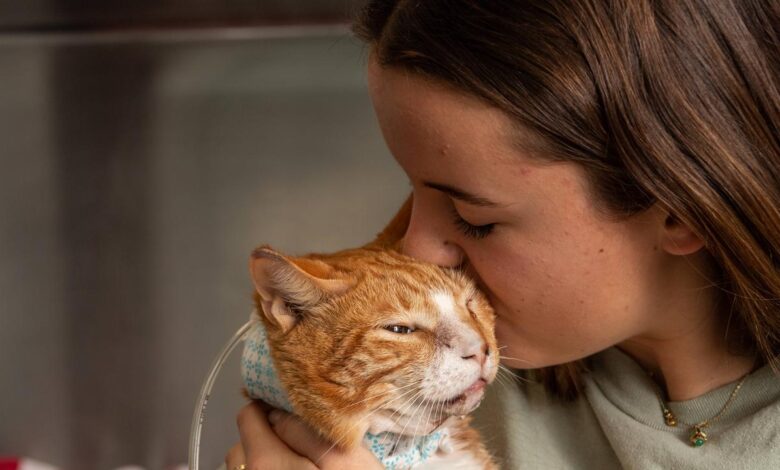The Enigmatic Elegance of the Big Pussycat: Feline Journey

In the world of wildlife, there exists a creature that embodies grace, power, and mystique in equal measure – the big pussycat. These magnificent felines, often referred to as big cats, represent a group of apex predators that have captured the human imagination for centuries. With their regal presence and predatory prowess, big pussycats have become symbols of both fear and fascination. In this article, we will embark on a journey to explore the diverse world of big pussycats, from their distinctive species to their vital role in the ecosystems they inhabit.
Defining Big Pussycats
Big pussycats, a colloquial term often used to refer to large wild cats, encompass a group of majestic carnivores belonging to the Felidae family. Unlike their domestic counterparts, these felines are true apex predators, dominating their respective habitats with strength and stealth. Among the most well-known big pussycats are the lion, tiger, leopard, cheetah, and jaguar, each boasting unique characteristics that set them apart.
The Lion (Panthera Leo)
The lion, often called the “King of the Jungle,” is an iconic symbol of strength and unity. Known for their sociable nature, lions live in pride, led by a dominant male. These magnificent creatures are found primarily in sub-Saharan Africa, where they are celebrated for their majestic manes and formidable roars.
The Tiger (Panthera tigris)
Tigers are renowned for their striking orange coat adorned with black stripes, making them the most recognizable big pussycats. With several subspecies distributed across Asia, the tiger is the largest of all cat species. Their solitary nature and elusive behavior have only added to their allure.
The Leopard (Panthera pardus)
Leopards are the ultimate stealth hunters, known for their ability to adapt to various habitats, from dense forests to arid grasslands. Their distinctive rosette-patterned coat helps them blend seamlessly into their surroundings, making them a formidable presence in the wild.
The Cheetah (Acinonyx jubatus)
The cheetah is the fastest land mammal, capable of reaching speeds of up to 60 miles per hour in short bursts. Their slender build and distinctive black “tear tracks” under their eyes distinguish them from other big pussycats.
The Jaguar (Panthera onca)
Jaguars are the largest big cats found in the Americas and are known for their powerful build and distinctive rosette-marked coat. They are skilled swimmers and are often associated with the lush rainforests of Central and South America.

Conservation Challenges
Despite their ecological importance and cultural significance, big pussycats face numerous challenges that threaten their survival. Habitat loss, poaching, and human-wildlife conflict are among the primary threats to these majestic creatures.
- Habitat Loss: The relentless expansion of human activities has led to significant habitat loss for big pussycats. Deforestation, urbanization, and agricultural development have fragmented their habitats, isolating populations and reducing genetic diversity.
- Poaching: The demand for big cat body parts and pelts in the illegal wildlife trade poses a grave threat. Tigers, in particular, are targeted for their bones and other body parts, believed to have medicinal properties in some cultures.
- Human-Wildlife Conflict: As human populations encroach further into big pussycat territories, conflicts between humans and these apex predators become more frequent. Livestock depredation can lead to retaliatory killings, further endangering big cats.
Big Pussycats in Their Ecosystems
These magnificent big pussycats play a crucial role in maintaining the balance of their ecosystems. Let’s delve into the unique ecological roles of some of these majestic felines:
Lion’s Pride:
In African savannas, lions serve as keystone species, exerting top-down control over herbivore populations. Their presence prevents herbivores from depleting vegetation, thereby maintaining the integrity of the ecosystem.
Tiger Territories:
Tigers are apex predators in the Asian forests they inhabit. They help control populations of herbivores such as deer and boar, ensuring the health of the forests they call home.
Leopard’s Adaptability:
Leopards are opportunistic hunters that adapt to a variety of environments. They play a crucial role in controlling small and medium-sized herbivores, preventing them from overgrazing and impacting plant communities.
Cheetah’s Speed:
Cheetahs primarily prey on small to medium-sized ungulates. Their speed allows them to catch prey efficiently, preventing herbivore populations from growing unchecked and causing habitat degradation.
Jaguar’s Rainforest Guardianship:
In Central and South American rainforests, jaguars are vital for maintaining the health of these ecosystems. They help control populations of herbivores and maintain a balance between predator and prey species.
Conservation Efforts
Numerous organizations and initiatives are dedicated to the preservation of big pussycats and their habitats. These efforts include:
- Protected Areas: The establishment of protected areas and national parks helps conserve the habitats of big pussycats, allowing them to thrive with minimal human interference.
- Anti-Poaching Measures: Enhanced anti-poaching efforts, including stricter law enforcement and penalties for wildlife crime, are critical to curbing the illegal trade in big cat parts.
- Community Engagement: Engaging local communities in conservation efforts can reduce human-wildlife conflicts and garner support for big cat protection.
- Research and Monitoring: Ongoing research on big cat populations and behavior helps inform conservation strategies and ensures their long-term survival.
- Captive Breeding Programs: Some organizations run captive breeding programs to bolster populations of endangered big pussycats and eventually reintroduce them into the wild.
Conclusion
Big pussycats, these enigmatic and charismatic creatures, are more than just symbols of power and grace; they are vital components of the ecosystems they inhabit. Their continued survival is a testament to the resilience of nature and the collective efforts of conservationists worldwide. By addressing the challenges they face and preserving their habitats, we can ensure that these majestic big pussycats continue to roam the wild and inspire awe and admiration for generations to come. It is our responsibility to protect these apex predators, ensuring their rightful place in the intricate tapestry of our planet’s biodiversity.
To know more about us Click Here





